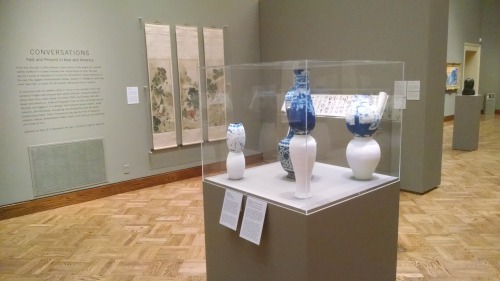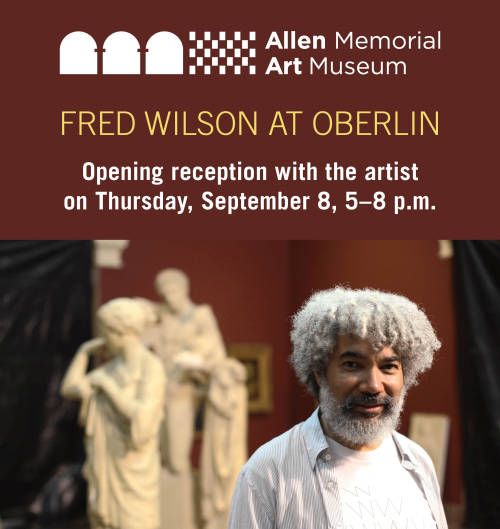#conversations past and present
Installation views of our exhibition Conversations: Past and Present in Asia and America on view through May 21, 2017.
Inspired by the AMAM’s 2016–17 theme of “Time,” this exhibition bridges wide temporal and cultural distances, linking the works of artists from China, Japan, Korea, the United States, and Canada, both well-known and anonymous, living and long gone. In the fall of 2016, the exhibition will feature paintings and calligraphy that reflect the lasting legacy of the Chinese literati tradition.
For the spring 2017 semester, a fresh rotation of works highlights adaptations by contemporary East Asian and Asian-American artists of the graphic sensibilities of Pop Art and Japanese ukiyo-e woodblock prints, along with the creative reworking of imagery from historical photographs. On view throughout the year will be contemporary ceramics that respond to various East Asian ceramic styles.
These “conversations” do not simply mimic the past, but engage it in a dialogue that references earlier subjects, styles, mediums, and techniques and infuses them with the artist’s contemporary reality. They may take the form of respectful imitation, creative reinterpretation, bitter critique, ironic send-up, and sometimes all of these at once.
The exhibition is organized by Kevin R.E. Greenwood, Joan L. Danforth Curator of Asian Art.
Post link
Mào Xiāng ranks among the most colorful characters in 17th-century China. Perhaps best known today as a poet and romantic, Mào also enjoyed considerable fame as a calligrapher during his own lifetime. He was a disciple of one of the most important calligraphers and painters of his age, Dǒng Qíchāng 董其昌(1555–1636).
The text of the calligraphy, recounting a visit to West Lake near the city of Hangzhou, is a well-known vignette from a travelogue by poet and essayist Yuán Hóngdào 袁宏道 (1568–1610). Yuán was a central figure in a group of late Ming writers and poets who believed that good writing originated from genuine feeling and authentic experience, rather than from strict imitation of traditional literary models. Throughout his short life, Yuán sought to balance tradition and innovation and to keep his perception of the world fresh. Although he died a year before Mào was born, the younger man undoubtedly became familiar with Yuán’s philosophy of life through their mutual friend, Dǒng Qíchāng. Mào’s choice of this text is an interchange both with Yuán (in part because he was also a bon vivant) and with his teacher, Dǒng, whose style of calligraphy Mào strongly alludes to in this scroll.
Now on view in the exhibition Conversations: Past and Present in Asia and America.
Image:
Mào Xiāng 冒襄(Chinese, 1611–1693)
Waiting for the Moon at Six Bridges, 17th century
Handscroll, ink on satin
Overall: 14 3/16 x 218 ½ in. (36 x 555 cm)
General Acquisitions Fund, 1970.39
Post link
This Thursday: Opening reception for fall exhibitions focusing on this year’s thematic concept of ‘Time.’ Artist Fred Wilson will be on hand for informal discussion about about his AMAM installation “Wildfire Test Pit,” as well as his works in the Ellen Johnson Gallery exhibition “Black to the Powers of Ten.” His acclaimed museum 'interventions’ often expose biases embedded within the history of art and material culture.
Other fall exhibitions include: “Piet Mondrian: Realism and Abstraction,” “Conversations: Past and Present in Asia and America,” which connects art that would otherwise be divided by temporal and cultural boundaries; “Time Well Spent: Art and Temporality,” which uses art from various time periods and mediums to examine how we define and perceive the idea of time; “Marking Time: Seasonal Imagery in Japanese Prints,” an installation highlighting the rich tradition of Japanese art and literature that evokes and represents seasonal change; “(Anti) Corporeality: Reclaiming and Re-presenting the Black Body,” featuring works by five contemporary artists that counter the dim history of pro-slavery ideologies; and an installation of two recently acquired works by the contemporary African artists El Anatsui and Malangatana Valente Ngwenya.
All museum galleries will be open for you to revisit old favorites, explore the new installations, discover new works, listen to our audio tours, or browse through our exhibition catalogs. AMAM staff and student docents will be on hand to answer questions and chat with you about the museum’s holdings.
Post link




